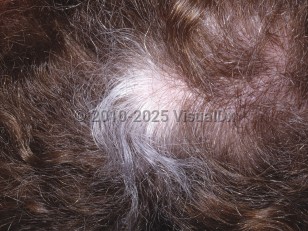Disorders of hair color - Hair and Scalp
Alerts and Notices
Important News & Links
Synopsis

Oculocutaneous albinism (OCA) is an inherited form of hair color change that affects hair globally. In OCA type 1, where tyrosinase activity is absent, hair is diffusely white. In OCA type 2, pigmentary dilution leads to yellowish hair, and in OCA type 3 (rufous albinism), hair is orange or red. Inherited gray or silvery hair syndromes include Chediak-Higashi syndrome, Griscelli syndrome, and oculocerebral hypopigmentation syndrome, Cross type. Premature graying is also seen in genetically inherited premature aging syndromes such as progeria and Werner syndrome.
Acquired disorders of hair color include drug-related or environment-related changes. The tyrosine kinase inhibitors (eg, imatinib, dasatinib, sunitinib), ipilimumab, and antimalarials may all lead to graying or whitening of hair. The phenomenon of repigmentation of gray hair has been reported with a number of different drugs, including anti-PD-1 therapy (such as nivolumab and pembrolizumab), thalidomide, lenalidomide, adalimumab, acitretin, etretinate, prednisone, cyclosporine, psoralen, interferon alpha, tamoxifen, levodopa, captopril, and certain vitamins (calcium pantothenate, para-aminobenzoic acid, vitamin B complex). For anti-PD-1 agents, repigmentation is thought to be a possible positive marker of tumor response. Milder changes in pigmentation, from dark to gray or gray to dark, may be seen with cytotoxic chemotherapies.
Development of green hair color, known as chlorotrichosis, may occur with prolonged exposure to the sun or to chlorinated water. This is particularly common in individuals with a lighter baseline hair color and in hair that has been chemically bleached. In the case of chlorinated water exposure, chlorotrichosis is thought to be due to insoluble copper deposition from copper plumbing.
Development of yellow hair color, known as xanthotrichia, has been observed in association with vitamin B12 deficiency, essential fatty acid deficiency, protein deficiency, tobacco use, tar shampoo use, selenium sulfide, and bacitracin zinc. Pathogenesis is ill-defined but is believed to be largely due to deposition of pigments by exogenous chemicals, tars, and tobacco by-products in acquired cases.
Focal absence of hair color is known as poliosis. This specifically refers to a localized patch or patches of white hair caused by reduced or absent melanin. Poliosis may also be inherited or acquired. If inherited, it may be isolated or may accompany a genetic syndrome, such as Waardenburg syndrome, piebaldism, or tuberous sclerosis. In this context, abnormal melanocyte migration from the neural crest is responsible. If acquired, poliosis may be secondary to autoimmune destruction of melanocytes. Examples include vitiligo, regrowing hair in alopecia areata, and a regressing nevus or melanoma.
In some systemic conditions, such as sarcoidosis and Tietz syndrome, poliosis may also affect the eyelashes, eyebrows, or body hair. Acquired eyelash poliosis has been reported in a number of ophthalmic conditions, including blepharitis and herpes zoster. It may also be triggered by topical administration of prostaglandin F2 analogues such as latanoprost. The pathogenesis of eyelash poliosis is not well-defined but is thought to be related to immunologic reactivity impacting melanocyte differentiation in melanin-rich hair follicles.
Focal hair repigmentation is a rarer phenomenon. Herpes zoster infection has been associated with developing localized permanent scalp hair repigmentation in some cases. Lentigo maligna and melanoma have been associated with the development of repigmentation of affected scalp hair. Paradoxically, in addition to eyelash poliosis, topical application of latanoprost has been associated with repigmentation of eyelashes and proximal scalp hair. The mechanism of repigmentation in the case of latanoprost is likely mediated by the prostaglandin F2α (PGF2α) receptor, which stimulates melanogenesis.
Codes
L67.1 – Variations in hair color
SNOMEDCT:
302931004 – Disorder of hair color
Look For
Subscription Required
Diagnostic Pearls
Subscription Required
Differential Diagnosis & Pitfalls

Subscription Required
Best Tests
Subscription Required
Management Pearls
Subscription Required
Therapy
Subscription Required
Drug Reaction Data
Subscription Required
References
Subscription Required
Last Updated:05/29/2024

